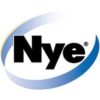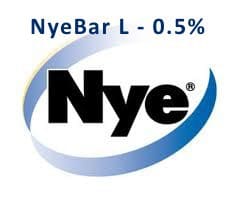Description
A Fluorocarbon Barrier Film to retard oil migration in mechanical devices and prevent environmental fouling of electric contacts and printed circuitry.
NyeBar – Type L is a stable fluorocarbon polymer with a surface energy well below the surface tension (at room temperature) of most lubricating fluids, including the easily-migrating silicones. The NyeBar polymer is supplied in solution in fast-evaporating perfluoralkane solvents. At room temperature, the film remaining after evaporation of the solvent will prevent “wetting” of the surface and creep of oils across the film surface. Spreading can, however, occur from gravitational or inertial forces, as when fluid quantity is sufficiently large that it literally “falls” across the barrier film; or when rotational speeds are sufficiently high that they sling the fluid over the film.
NyeBar – L films can endure temperatures to 200°C and can control creep of even low surface tension methyl silicone oils at that temperature. The principal vulnerability of the applied film would be its resistance to abrasion. Handling of treated parts should be minimized.
Application of NyeBar:
NyeBar – Type L can be applied to any clean metal, plastic or glass surface by dipping the component in the solution, by spraying the solution on the part, or, for small areas of a device, by brushing the area to be protected. Air drying for five minutes permits evaporation of the carrier solvent, and a very thin but fully effective film will remain. Some customers have found that baking the applied film for 10 minutes at 90°C produces a more durable and abrasion resistant film and reduce the surface energy.
Prevention of Lubricant Migration:
When using NyeBar – Type L to prevent migration of lubricating oils, the NyeBar solution should not be applied in the area requiring lubrication but rather as a dam or barrier around that area. For a pivot bearing, a “doughnut” around the pivot is a useful solution. Where it is desired to prevent oil from spreading along a rotating shaft, a simple ring around the shaft should suffice. For ball bearings, inner and outer race faces should be coated with barrier film. Shields, shims, shield retainers and retaining rings should be coated also. Extreme care should be taken that no barrier film be permitted to contact bearing race lands, separators, balls or ball grooves.
We strongly recommend that you take a look at the Technical Data Sheet for NyeBar L.
Material Safety Data sheet available upon request.
NyeBar – Type L is a stable fluorocarbon polymer with a surface energy well below the surface tension (at room temperature) of most lubricating fluids, including the easily-migrating silicones. The NyeBar polymer is supplied in solution in fast-evaporating perfluoralkane solvents. At room temperature, the film remaining after evaporation of the solvent will prevent “wetting” of the surface and creep of oils across the film surface. Spreading can, however, occur from gravitational or inertial forces, as when fluid quantity is sufficiently large that it literally “falls” across the barrier film; or when rotational speeds are sufficiently high that they sling the fluid over the film.
NyeBar – L films can endure temperatures to 200°C and can control creep of even low surface tension methyl silicone oils at that temperature. The principal vulnerability of the applied film would be its resistance to abrasion. Handling of treated parts should be minimized.
Application of NyeBar:
NyeBar – Type L can be applied to any clean metal, plastic or glass surface by dipping the component in the solution, by spraying the solution on the part, or, for small areas of a device, by brushing the area to be protected. Air drying for five minutes permits evaporation of the carrier solvent, and a very thin but fully effective film will remain. Some customers have found that baking the applied film for 10 minutes at 90°C produces a more durable and abrasion resistant film and reduce the surface energy.
Prevention of Lubricant Migration:
When using NyeBar – Type L to prevent migration of lubricating oils, the NyeBar solution should not be applied in the area requiring lubrication but rather as a dam or barrier around that area. For a pivot bearing, a “doughnut” around the pivot is a useful solution. Where it is desired to prevent oil from spreading along a rotating shaft, a simple ring around the shaft should suffice. For ball bearings, inner and outer race faces should be coated with barrier film. Shields, shims, shield retainers and retaining rings should be coated also. Extreme care should be taken that no barrier film be permitted to contact bearing race lands, separators, balls or ball grooves.


